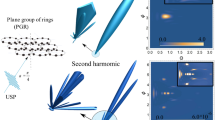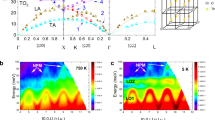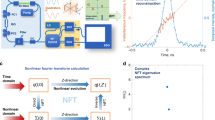Abstract
IN evaluating the effect of the atomic movements in a crystal on the propagation of a beam of X-rays through it, such of these movements as may be identified with the elastic modes of vibration of the solid may be taken up first for consideration. Each of these modes presents a distinctive pattern of nodal surfaces, the frequency of the oscillation being the same everywhere and the phase being opposite in every pair of adjacent cells in the pattern. The configuration of the nodal surfaces in any given mode is determined by various macroscopic factors, namely, the form of the crystal, the external boundary conditions and the elastic anisotropy, besides being dependent on the frequency of the mode. Hence, it would bear no particular relation to the atomic architecture of the crystal and would also be different for each of the numerous possible modes. These circumstances have important consequences in relation to the optical aspects of the problem. Each atom in the track of the X-ray beam may be considered as a source of secondary radiations of frequencies ν, ν + ν* and ν– ν*, ν being the frequency of the X-radiation and ν* that of the elastic vibration under consideration, and their effects have to be summed up over the illuminated volume. Since the amplitudes and phases of the radiations of modified frequency depend on the amplitudes and phases of the atomic movements, they would vary from atom to atom in a manner determined by the configuration of the nodal pattern, and hence would be different for each different ν* and in no case would be definitely correlated with the internal architecture of the crystal. It follows that these scattered radiations cannot possibly give rise to any geometric diffraction pattern exhibiting an observable relationship to the structure of the crystal.
This is a preview of subscription content, access via your institution
Access options
Subscribe to this journal
Receive 51 print issues and online access
$199.00 per year
only $3.90 per issue
Buy this article
- Purchase on Springer Link
- Instant access to full article PDF
Prices may be subject to local taxes which are calculated during checkout
Similar content being viewed by others
References
Proc. Ind. Acad. Sci., A, 18, 237 (1943).
Proc. Ind. Acad. Sci., A, 26, 339 (1947).
Current Science, 9, 165 (1940).
Author information
Authors and Affiliations
Rights and permissions
About this article
Cite this article
RAMAN, C. X-Rays and the Eigen-Vibrations of Crystal Structures. Nature 162, 23–24 (1948). https://doi.org/10.1038/162023b0
Issue Date:
DOI: https://doi.org/10.1038/162023b0
This article is cited by
-
X-Ray Scattering by Thermal Vibrations in Crystals
Nature (1948)
-
The dynamic X-ray reflections in carbon silicide
Proceedings of the Indian Academy of Sciences - Section A (1948)
Comments
By submitting a comment you agree to abide by our Terms and Community Guidelines. If you find something abusive or that does not comply with our terms or guidelines please flag it as inappropriate.



